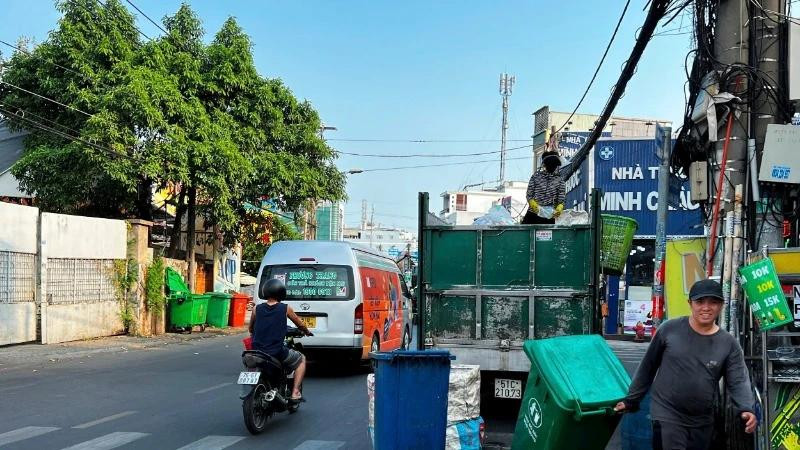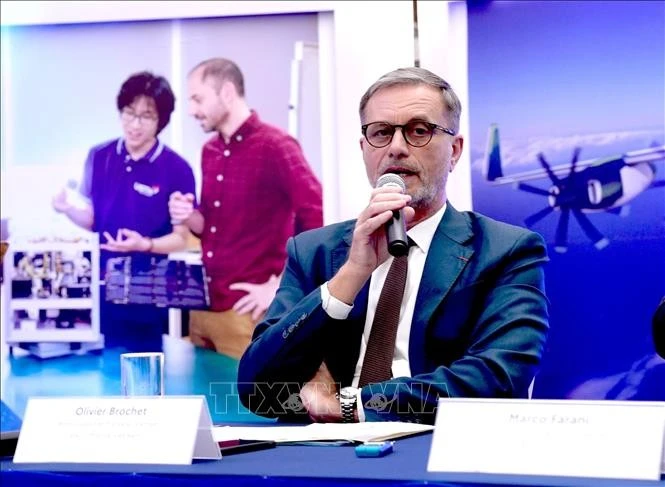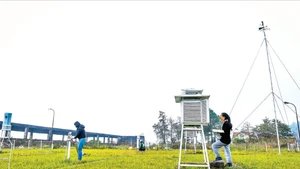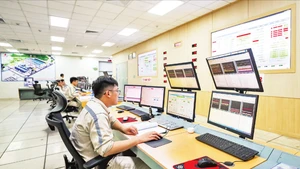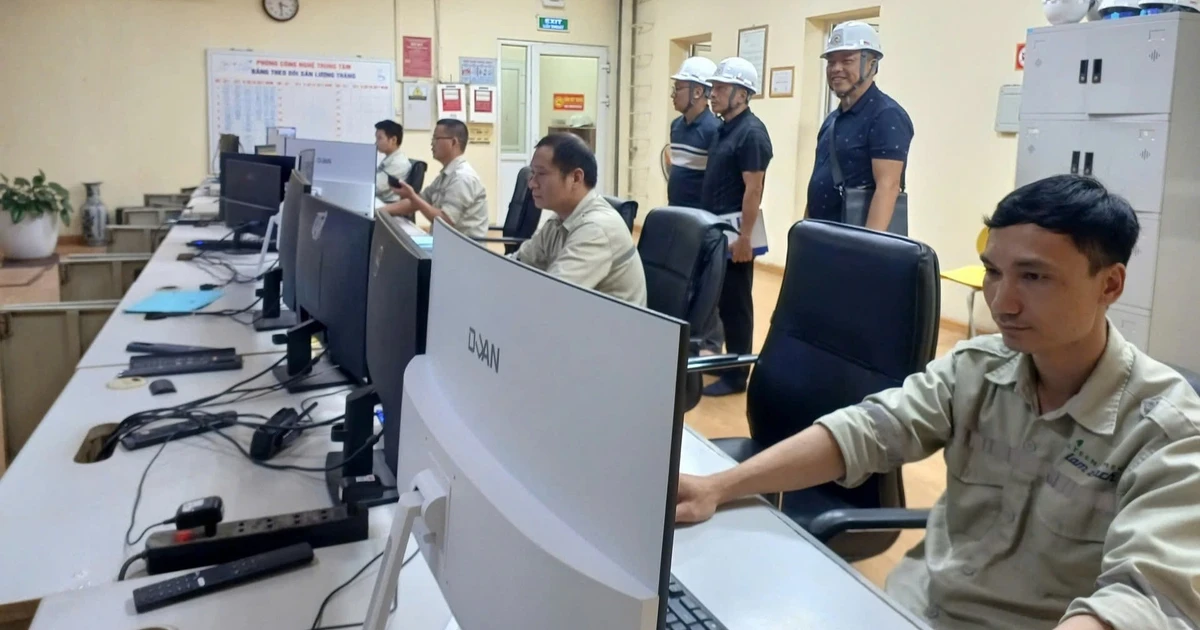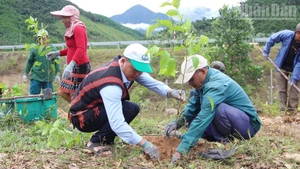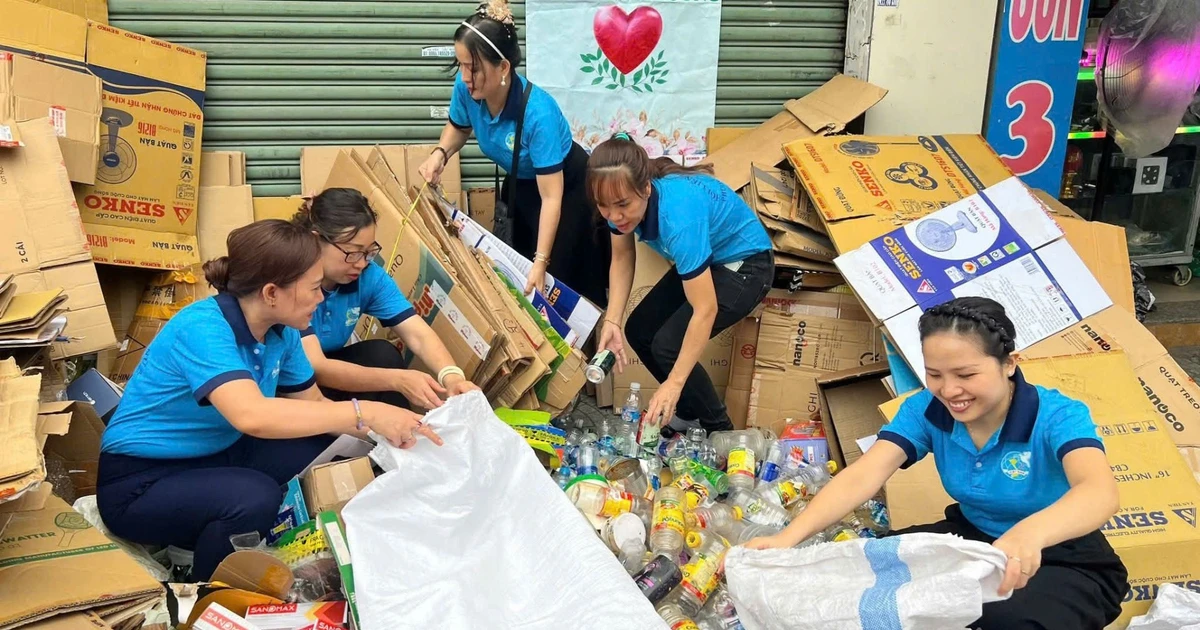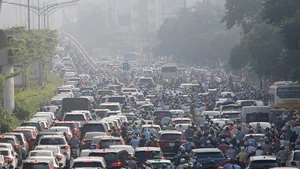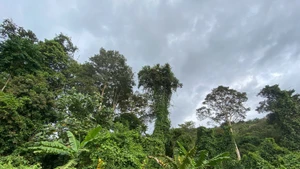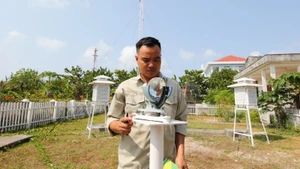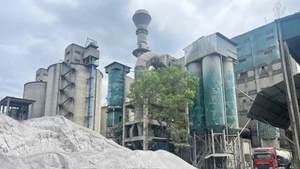This mindset introduces a new approach, where household solid waste (commonly known as garbage) is no longer considered mere waste but can become a "green" economic sector if properly sorted, collected, and processed. However, turning this perspective into reality requires synchronisation between policies, investments, technical infrastructure, and the participation of the entire society, from individuals and businesses to all levels of authorities.
Sorting waste at the source has been promoted in major cities for years, but its effectiveness remains limited. Many waste classification initiatives started with great enthusiasm but quickly faded.
Exciting start, quiet end
Every evening, the bell rings out, signalling the time for garbage collection in many small alleys across Hanoi's residential areas. From their homes, residents carry their trash to the door and throw it into the waiting garbage collection cart. At the same time, a sanitation worker uses a shovel to spread the garbage bags evenly in the cart to make room for more waste. Without colour-coded bags for differentiation, everything is mixed—glass bottles, beer cans, scrap paper, and even leftover food emitting a strong odour. For many people, the waste remains an undifferentiated mess, with no need for sorting, despite the government's prolonged efforts to promote source separation.
In reality, local authorities have been calling for waste sorting long before the Environmental Protection Law took effect. Years ago, a waste separation project was implemented in Hanoi with financial support from JICA’s (Japan International Cooperation Agency) Development Partnership Program in certain areas. The project provided two types of waste bins for some households and schools. Initially, residents responded enthusiastically, and the sorting rate was relatively high. However, garbage collection reverted to its previous practices once the project ended.
Similarly, in Ho Chi Minh City, programs such as the "Green Living Festival" and "Recycling Day" attracted significant participation. However, maintaining these initiatives proved challenging, causing them to be forgotten until another launch event.
Nguyen Van Quy, Head of the Solid Waste Management Division at the Hanoi Department of Agriculture and Environment, stated that household solid waste classification regulations were already mentioned in the Environmental Protection Law of 2005 and 2014. However, these laws only encouraged waste sorting without specific mandatory regulations. As a result, before 2020, waste separation at the source was implemented only as a pilot program with support, but once the projects ended, so did the sorting efforts.
Pham Minh Cuong, Deputy Head of the Waste Management Division at the Department of Environment, assessed that the root cause was the lack of synchronisation in technical infrastructure from the pilot stage. The waste sorting, collection, transportation, and treatment processes should have been designed as an integrated system. However, in reality, even when residents sorted waste, it was still collected together in the same vehicle and transported to the same treatment site. This approach left even the most conscientious citizens feeling powerless, making their efforts seem futile. Consequently, the goal of waste classification at the source did not achieve the expected effectiveness.
Lack of market demand—Waste remains waste
Beyond the classification issue, finding markets for recyclable waste is also problematic. Many localities are confused because recycling infrastructure is insufficient or underdeveloped.
In Phu Tho Province, despite two attempts over the past decade to develop plans for waste collection, transportation, and treatment, these plans have yet to incorporate the development of new recycling facilities. Moreover, even the maintenance and expansion of existing facilities have not received adequate attention. A prime example is the Viet Tri Urban Waste Processing Plant, built in 1998, which was designed to recycle organic waste into compost for agriculture and process inorganic waste such as bricks, glass, and stones into construction materials. However, this plant now faces the risk of closure as the Tram Than Waste-to-Energy Plant (in Phu Ninh District) has commenced operations, leading to a prioritisation of waste being directed to the waste-to-energy facility to meet the contractual obligation of processing at least 400-500 tons of waste per day. This reality creates a contradiction: if waste is sorted according to standards, there may not be enough to sustain the waste-to-energy plant, but if waste collection remains mixed, it contradicts the Environmental Protection Law's regulations on waste classification.
Besides Phu Tho Province, in Ho Chi Minh City, approximately 10,000 tons of household waste are generated daily, excluding industrial, construction, and medical waste. This figure is expected to rise with population growth, urban expansion, and improved living standards. Currently, waste is directed to the Tay Bac Solid Waste Treatment Complex in Cu Chi District, which receives about 5,700 tons per day, and the Da Phuoc Waste Treatment and Cemetery Complex, which handles about 4,000-4,200 tons per day. However, waste treatment methods mainly rely on landfill disposal, leading to consequences such as water leakage and air pollution. Recyclable waste such as plastic, metal, and paper has yet to be processed in standardised recycling facilities. Instead, it is collected by small, unregulated recycling units that do not meet environmental standards.
One of the critical factors for effective waste classification is establishing appropriate outlets for different types of waste. However, this challenge remains unsolved. In reality, the process of sorting and treating waste is caught in a vicious cycle: citizens do not sort their waste because they do not see the benefits; the low volume of sorted waste discourages recycling businesses from investing; and ultimately, most waste ends up in landfills as if it had never been classified.
According to the Ministry of Agriculture and Environment statistics, the total daily waste generation in 2024 was 69,503 tons. With an average cost of 50 USD per ton for collection, transportation, and treatment, the country spends nearly 3.5 million USD daily, amounting to approximately 1,277.5 million USD per year. Such high costs pose economic challenges for a developing country like Vietnam, with far-reaching social and environmental implications.
According to the Environmental Department of the Ministry of Agriculture and Environment, food waste accounts for the largest proportion of daily waste, ranging from 50% to 70%. If properly classified at the household level, this waste could be used to produce high-quality compost or converted into biomass energy. Additionally, recyclable waste, which constitutes about 20%-25% of total waste, serves as a valuable raw material for manufacturing processes. Other household waste such as plastic bags, candy wrappers, foam boxes, and wooden scraps, although of low value, can still be processed into fuel pellets for industrial use. This means that nearly all generated waste has the potential to be recycled, reused, or converted into energy, creating economic value.
However, around 65% of waste is still disposed of through landfilling, approximately 16% is processed at composting plants, and about 19% is treated through incineration and other methods such as recycling, gasification, and fuel pellet production.
Given the current state of waste classification and treatment, valuable economic resources are being lost daily while additional costs are incurred for waste collection and disposal. Consequently, the opportunities for recycling and reuse remain underutilised.
